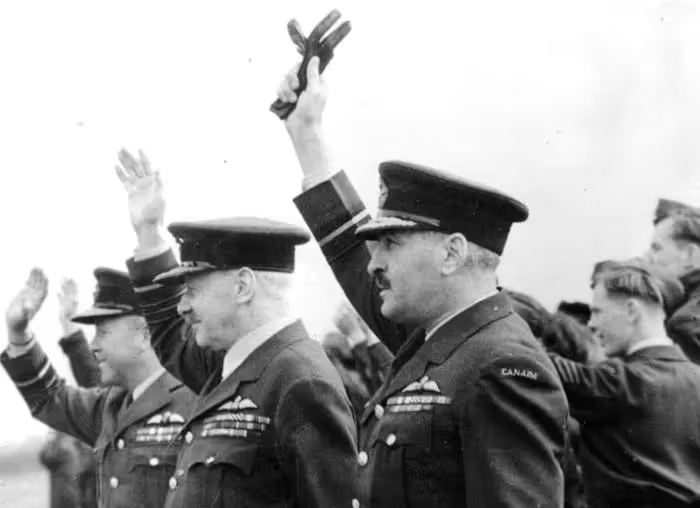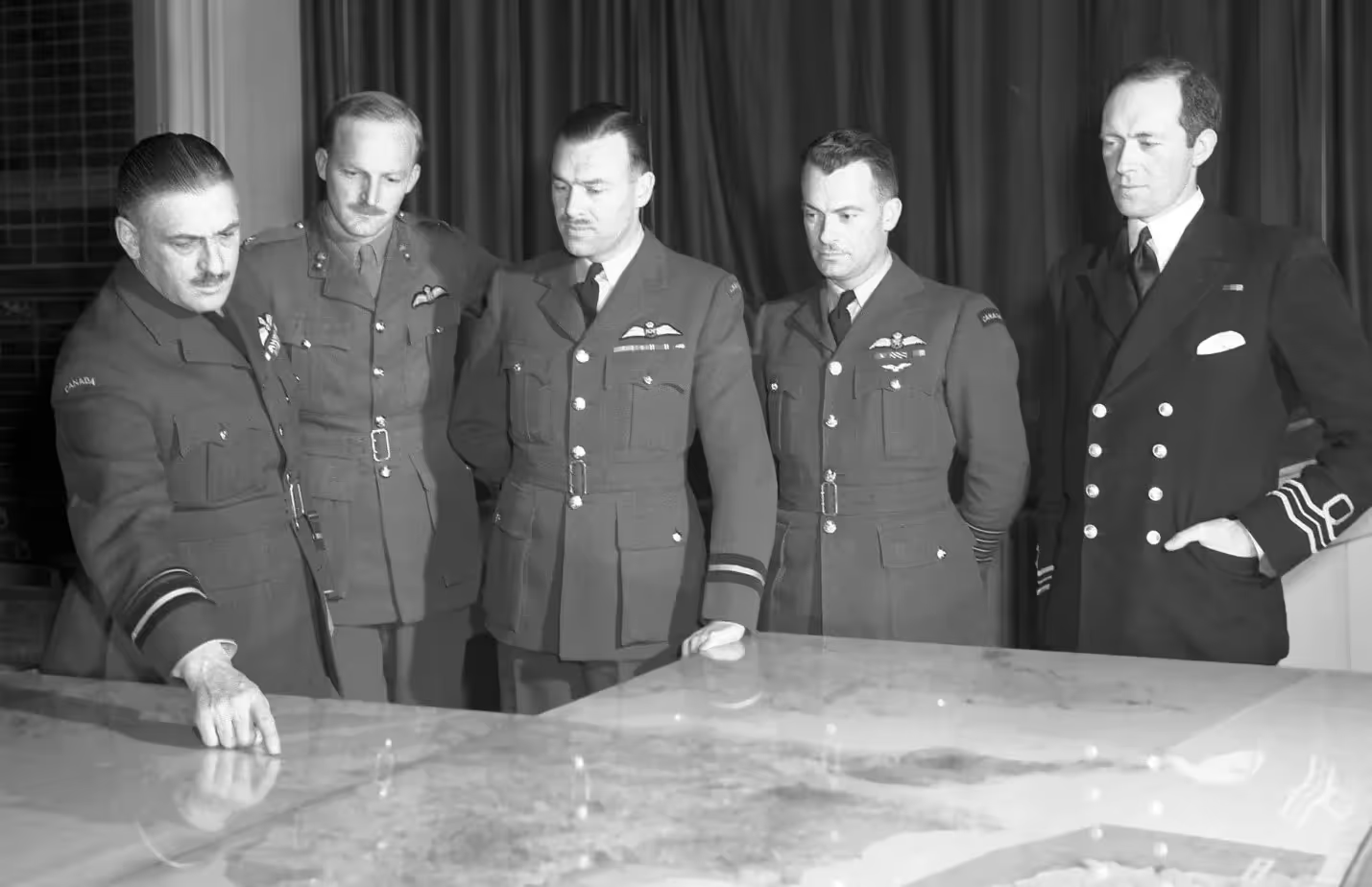RCAF Aviation History: Air Vice Marshal Clifford Mackay McEwen CB, MC, DFC and Bar
Air Vice Marshal Clifford Mackay McEwen CB, MC, DFC and Bar

(DND Photo)
Air Vice Marshal Clifford Mackay McEwen CB, MC, DFC & Bar Italian Medal Volori and Croce de Guerra, French Legion of Honour, American Legion of Merit, Companion of the Most Honourable Order of the Bath, MiD (2 July 1896 – 6 August 1967) was a fighter ace in the British RoyalFlying Corps during the First World War and a senior commander in the Royal CanadianAir Force during World War II. His Second World War service culminated in hiscommanding No. 6 Group RCAF in England from 28 February 1944 to 13 July 1945.
During his command, the performance of the RCAF was greatly improved, becoming the most successful Allied bombing force in severalways. By late 1944 the RCAF had both the best survival rate and the highest accuracy of any bombing force. McEwen was born on 2 July 1896 in Griswold, Manitoba and grew up in Moose Jaw, Saskatchewan.(Wikipedia)

(Air Force Museum of Alberta Archives Photo, AF2012.034). 1957.
During his service in the First World War as a fighter pilot with both the Royal Flying Corps and Royal Air Force, McEwen was awarded the Military Cross, the Distinguished Flying Cross and Bar. Flying a Sopwith Camel alongside William Barker with No. 28 Squadron RFC/RAF in northern Italy, McEwan wascredited with 27 aerial victories and the squadron’s highest scorer.
He remained in Canadian aviation service throughout the interwar period. Duringthe Second World War he was appointed to No. 6 Group RCAF in England and ledthe 15 bomber squadrons under his command from their training days to theirlong-range bombing operations.
CliffordMcKay McEwen was born inGriswold, Manitoba in 1896. He grew up in Moose Jaw, Saskatchewan, attendingthe provincial university with plans to become a clergyman. The First World Warintervened, and he enlisted in early 1916 in the 196th (Western Universities) Battalion of the Canadian Expeditionary Force bound for Europe.
Whilein England, and now a Corporal, McEwen was commissioned as a 2ndLieutenant and seconded to the RFC. Demonstrating exceptional flying skill, hewas sent to No. 28 Squadron to fly fighters in France in Oct 1917. That month,the Italian Army suffered a devastating defeat at the hands of German forcesthat were bolstering their Austrian allies. No. 28 Squadron was ordered to theItalian front. In keeping with the Squadron motto, “Quicquid Agas Age” –Whatsoever You May Do, Do, McEwen eventually racked up a score of27 enemy aircraft. He shot down an Albatross DIII near Conegliano on 30 Dec 1917 and ended his score with the destruction of an Albatross DV over theTagliamento River on 4 Oct 1918. In addition to the MC and DFC & Bar, hewas awarded Italy’s Bronze Medal for Military Valour. In the citation for his DFC Bar, McEwen was described as “A brilliant and courageous pilot who has personally destroyed twenty enemymachines. Exhibiting entire disregard of personal danger, he never hesitates to engage the enemy, however superior in numbers, and never fails to inflict serious casualties. His fine fighter spirit and skillful leadership inspired allwho served with him.”
With the end of the war on 11 Nov 1918, Captain McEwen was posted to No. 1 Squadron inthe newly established Canadian Air Force in England. Demobilized back to Canadain 1919, he joined the semi-military Air Board with Canadian Commercial Pilotlicense No. 73 and became a flying instructor at Camp Borden, Ontario. About this time, he acquired the nickname ‘Black Mike’. As he told biographer Arthur Bishop it was “Nothing sinister, I just happen to tan easily.”
When the RCAF was established in 1924, McEwen was commissioned a Flight Lieutenant and became active in aerial survey operations. His promotion to Squadron Leader came in 1929 and to Wing Commander in 1937. During these interwar years he flew all types of aircraft on strength with the RCAF and attended the RAF Staff College at Cranwell.
Bythe outbreak of the Second World War, McEwen was a Group Captain in charge ofRCAF Station Trenton, Ontario, and heavily involved with the buildup ofCanada’s wartime air force. Promoted Air Commodore during 1941, he went to No.1 Group, Eastern Air Command, Newfoundland, which was engaged in anti-submarinewarfare against the German U-boat threat to convoy shipments to a beleagueredBritain. It was during these early days of the Battle of the Atlantic that McEwen grew a reputation as a seriouslydisciplined leader.
Aftertwo years McEwen was sent to RAFLinton-on-Ouse in England. A Mention In Dispatches several months later states:“This officer was appointed base commander at No. 62 Operational Base in June1943; since then, five squadrons have either formed or converted after movementinto the base, Air Commodore McEwen has by his untiring efforts andleadership brought the base to a very high level of operational efficiency. Hisability and zeal have been worthy of the highest praise.”
Duringthis same period, a strong political move had been made to have Canadian airmenserve together as a united fighting force rather than being deployedindividually into Royal Air Force squadrons. To this end, No. 6 Group wasformed within RAF Bomber Command as an RCAF entity in January 1943. Its firstyear had been less than stellar. Based in Yorkshire, the Group had the longestdistance to fly to reach the enemy coast. Combat losses were high due totraining deficiencies and tactical shortcomings in the growing tempo of taking the war to the enemy until Allied armies could land in Europe. In the words of historian David Bashow, “No. 6 Group was a formation in shock and feeling sorryfor itself. In short, it was a unit in need of tough love. Perhaps the mostdifficult problems to overcome were the significant morale problems generatedby the losses themselves…”
InFeb 1944, McEwen was promotedAir Vice-Marshal and became Air Officer Commanding No. 6 Group RCAF. Acceptedas someone who had proved his mettle in the First World War; he initiallydismayed his personnel by implementing a program of arduous and demandingtraining along with stern discipline. However, A/V/M McEwen was not a desk pilot. He led inthe air, often accompanying his airmen on difficult enemy targets. Althoughofficially prohibited from flying operationally, a suitably uniformed ‘Sergeant’McEwen, was known to quietly slip aboard a Berlin-boundLancaster or Halifax bomber from time to time. The airmen of No. 6 Group grewto fully appreciate a commander who knew and shared their dangers.
Overall,McEwen was very awareof the pressures endured by his stressed aircrews and overworked ground crews.When not flying himself he never slept during the nights that his Group wasoperational and would informally meet and greet his returning aviators at theirdebriefings. Furthermore, in recognition of their outstanding efforts heordered that base commanders increase their number of submissions for honoursand awards. Group Captain Johnnie Fauquier, then leading No. 62 Base, recalled that each squadron was to submit aminimum of ten recommendations monthly in addition to Immediate Action Awards.

(Bomber Command Museum of Canada Photo Collection)
RCAF Air Vice-Marshal Clifford Mackay “Black Mike” McEwen, commander of No. 6 Group, RCAF in the foreground, RAF Air Vice-Marshal Arthur “Bomber” Harris, in the middle, and RCAF AirMarshal G.O. Johnson, AOC RCAF Overseas, in the background, wave goodbye to thefirst of 141 Canadian Lancasters departing for Canada from RAF Middleton St. George, in the UK.
One of theAvro Lancaster Mk. Xs destined to join Tiger Force was Lancaster (Serial No.KB999), the 300th Canadian-built Lancaster. When it came off the assemblyline in Malton, Ontario, Victory Aircraft Corporation production staffdedicated this aircraft to A/V/M McEwen and had his pennant painted on the nosewith the words “Malton Mike”. After the end of the war, KB999 wasassigned to the No. 405 Vancouver Squadron, RCAF, and flew A/V/M McEwan toCanada on 17 June 1945.
Bythe end of 1944, under McEwen’s able stewardship, No. 6 Group’s combat loss rate became the lowestof all Groups of heavy bombers. They also became the most efficient. The AOCBomber Command, Air Marshal Sir Arthur Harris, RAF, lobbied eloquently (andforcefully) to obtain a knighthood for McEwen’s contribution to the war effort but Canadian regulations forbade theacceptance of titles. In the event, McEwen was made a Companion of theOrder of the Bath with King George VI bestowing that decoration on him in Feb1945 at Buckingham Palace.
Inthe months that followed, France named McEwen an Officer of the Legion ofHonour with special mention for the efforts of No. 6 Group during the D- Dayinvasion and the liberation of their nation. After VE Day, the United Statesappointed him a Commander of the Legion of Merit with the words: “Hisoutstanding achievements on the headquarters staff and as the operational commanderof the Canadian bomber group, in planning and executing the RCAF’s part in theclose cooperation which has existed between the United States Army Air Forceand the British air services, and his success in advancing cordial relationsbetween these services have been outstanding characteristics of his fine work.These achievements are a reflection of his effective association with theUnited States forces in his previous position of Air Officer Commanding No. 1Group, Eastern Air Command, whose cooperation between the services was thefoundation of their success.”
WithGermany defeated, McEwen was appointed to command thebomber group of Tiger Force. Tasked to deploy to the Pacific to assist in thewar effort against Japan, this Canadian Force was rendered unnecessary afteratomic bombs were dropped on the Japanese cities of Hiroshima and Nagasaki.
AirVice-Marshal Clifford MacKay McEwen retired in 1946 after anextraordinary 30-year career. Taking up residence in Montreal, he continued tocontribute to aviation development as managing director of Trans CanadaAirlines, the forerunner of today’s Air Canada. He also took a strong interestin the men who had served under him during the war, by championing veterans’causes. He served as the national vice-president of the Canadian Legion and asa long time president of the Dominion Council of the Last Post Fund. He diedduring Canada’s Centennial Year 1967 and was buried at the Last Post’s Field ofHonour in Pointe Claire, Quebec. McEwen was survived by his wife of 40years and three daughters.
AirChief Marshal ‘Bomber’ Harris opined in his memoires that McEwen had received too little appreciation. In truth, it is the diminishing number of Canadian Veterans whoserved with him, offshore from their homeland, that best knew Black Mike. He had led them by example – albeit in the guise of a Sergeant Pilot. He was Canada’s highest-ranking airman to have flown in combat during the Second WorldWar. In 2003 CFB Moose Jaw, Saskatchewan, was officially named Air Vice-MarshalC.M. McEwen Airfield. (J. AllanSnowie)

(RCAF Archives Photo)
Headquarters, RCAF 6 Bomber Group Overseas - 23 May 1944
Air Vice Marshal C.M. McEwen, MC, DFC and Bar, Air OfficerCommanding, discusses a point of interest with some of his senior officers.Beside him are, left to right: Major A.K.L. Stephenson, Nelson, BC.; Air Commodore C.R.Slemon, CBE, Winnipeg and Bomanville, Ontario,senior air staff officer; Group Captain J.E. Fauquier, DSO and Bar, DFC, Ottawa, in charge ofoperations; and a Lieutenant-Commander, Royal Navy, 23 May 1944. All branchesof the armed services worked in close harmony as bombing operations againstenemy targets were carefully planned at headquarters of RCAF No. 6 Bomber Groupin the UK.





